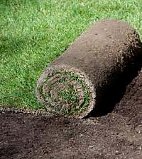 Installing sod is the quickest way to establish a new lawn or repair and old one. Sod is professionally grown turf grass consisting of densely growing grass that can be used to create an instant lawn. Well, not quite so, regular watering is required to establish the grass by encouraging the roots to penetrate the soil bed. Using sod is a more expensive way of having a beautiful lawn but is has some advantages. In addition to instant gratification it offers a denser, healthier lawn that is relatively weed free. It is easier to install on slopes and in shade, and can be planted in almost any season when the ground is not frozen. Sod sounds good, right? But to get the most out of your sod you must choose it carefully.
Installing sod is the quickest way to establish a new lawn or repair and old one. Sod is professionally grown turf grass consisting of densely growing grass that can be used to create an instant lawn. Well, not quite so, regular watering is required to establish the grass by encouraging the roots to penetrate the soil bed. Using sod is a more expensive way of having a beautiful lawn but is has some advantages. In addition to instant gratification it offers a denser, healthier lawn that is relatively weed free. It is easier to install on slopes and in shade, and can be planted in almost any season when the ground is not frozen. Sod sounds good, right? But to get the most out of your sod you must choose it carefully.
Many different kinds of sod are grown and several factors should be considered when choosing sod.
Grass Selection: Sod is composed of one or more grasses each with unique characteristics. The specific grasses you want will depend on:
 Climate
Climate
- Grasses may be warm-season grasses, cool-season grasses or a mixture. Generally, the various kinds of sod that are available in your area will probably consist of grasses that will grow well in your area but you might like some grasses better than others.
 Light If the sod is going to be planted in a shade you will want shade tolerant grasses.
Light If the sod is going to be planted in a shade you will want shade tolerant grasses.
 Use If the area is going to get a lot of wear and tear you will need a sod that has traffic-tolerant grasses.
Use If the area is going to get a lot of wear and tear you will need a sod that has traffic-tolerant grasses.
No matter what kind of grasses you choose, the sod should be fresh and healthy. Look for the following characteristics:
 Dense, lush, uniformly green leaves about 2” or more long (yellow or uneven length blades may indicate that the sod has been sitting around too long).
Dense, lush, uniformly green leaves about 2” or more long (yellow or uneven length blades may indicate that the sod has been sitting around too long).
 Root-soil thickness 1 inch. Thinner sod dries out to quickly, thicker sod will have a hard time adjusting to the soil bed.
Root-soil thickness 1 inch. Thinner sod dries out to quickly, thicker sod will have a hard time adjusting to the soil bed.
 Soil around roots moist but not dripping wet.
Soil around roots moist but not dripping wet.
 Roots knit together (avoid netting used by growers to bind the sod together as t may become a problem in your lawn)
Roots knit together (avoid netting used by growers to bind the sod together as t may become a problem in your lawn)
 No thatch
No thatch
 Sod cool to the touch (sod becomes warm as it decomposes).
Sod cool to the touch (sod becomes warm as it decomposes).
Although you can plant sod any time the ground has not frozen, the best time is during the period of greatest growth. For warm-season grasses that is in the summer; for cold-season grasses it is in early spring or early fall. Have the soil bed completely prepared before you buy the sod so that you can plant it immediately because sod that sits around for a day or two, dries out and will not grow well. Water the sod regularly especially in hot dry weather.
